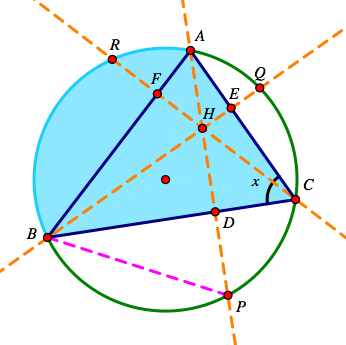
Assignment 8: Exploration 11
Altitudes and Circumcircles
by Michael Ferra
Proposed Investigation
Construct any acute △ABC and its circumcircle. Construct the three altitudes AD, BE, and CF. Extend each altitude to its intersection with the circumcircle at corresponding points P, Q, and R.
i. Prove
i. Prove
Let's begin by first looking at our given image above. We can make a few notes on our observations that may or may not be helpful to us later.
So what observations can be made?
AP = AD + DP
BQ = BE + EQ
CR = CF + CR
Notice there are also several ways we can describe the area of △ABC. Let's just name a few:
(1) Area△ABC = (1/2)(AD)(BC)
(2) Area△ABC = (1/2)(BE)(AC)
(3) Area△ABC = (1/2)(CF)(AB)
(4) Area△ABC = Area△BCH + Area△ACH + Area△ABH= (1/2)(BC)(DH) + (1/2)(AC)(EH) + (1/2)(AB)(FH)
These features are readily visible from our image but let's delve a little further to see if we can't find something else that may be useful. Observe the following image.
Using this image as well as some geometric properties, I'd like to show that segment DH is congruent to to segment DP so I can add this to my useful tools in case I need them later in our proof. So let's find a way to show this.
Notice I've shaded two regions which is intended to show the area of two different triangles. So let's look at the areas of △BDH and △BDP. If I can show these two triangles are congruent then I can conclude each side and angle of △BDH will be congruent to a certain side and angle of △BDP.
Notice these two triangles have a common side with length BD so let's use this as our base. Line AP is already perpendicular to segment BD, so for △BDH and △BDP, the altitudes are already defined as DH and DP respectively thus m∠BDH = 90° = m∠BDP. So thus far we've stated the congruences of △BDH and △BDP to include BD ≅ BD and ∠BDH ≅ ∠BDP. If we could state another unique angle of △BDH is congruent to a unique angle of △BDP then we could conclude △BDH ≅ △BDP by the Angle Side Angle Theorem (ASA). So let's work on this next.
If we go a little astray from specifically working with △BDH and △BDP we can observe our entire figure again and observe that ∠ACB and ∠BPA subtend the same arc, thus ∠ACB ≅ ∠BPA. Let's denote m∠ACB = m∠BPA = x. I've illustrated these angles subtend the same arc below and labeled the measure of these angles as x.

Thus looking at △BDP, if we know m∠BPD = x and m∠BDP = 90° then m∠DBP = 90 -x. Let's observe △BCE, we know m∠BCE = x and m∠BEC = 90°, thus m∠CBE = 90 - x. We know ∠CBE ≅ ∠DBH, thus looking back at △BDH, we now know m∠DBH = 90 - x and m∠BDH = 90°, therefore m∠BHD = x. This now proves m∠BHD = x = m∠BPD thus m∠BHD ≅ m∠BPD.
Since BD ≅ BD, ∠BDH ≅ ∠BDP, and m∠BHD ≅ m∠BPD, then △BDH ≅ △BDP by the ASA. We can therefore conclude DH ≅ DP.
By this same logic we can conclude that FH ≅ FR and EH ≅ EQ.
Now let's return to what we want to prove, which once again is:
From the work we've completed thus far, we know:
Show
.
Recall the ways we defined the area of △ABC from earlier. Let's use two of those statements and set them equal to each other since they are all equivalent statements. I'm going to set area statements (4) and (2) equal to each other and continue working from there.
With the statement as is, there is no more we can simplify unless we go back and make use of some of the useful tools we defined earlier. Let's once again go back to our area statements for △ABC. We know statements (1), (2) and (3) are equivalent therefore we can deduce (AD)(BC) = (BE)(AC) = (CF)(AB). Let's now make the appropriate substitutions.
Now that we've shown this, let's bring everything together to make a final conclusion.
▩